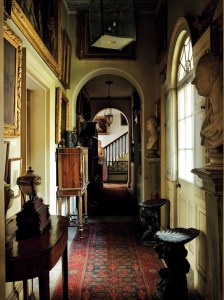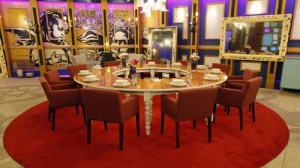The contents of Avenue House in Ampthill – the collection assembled by Sir Albert Richardson (1880–1964), architect, historian, writer, artist, teacher and sometime President of the Royal Academy – is now being sold by Christie’s in London. Richardson moved into the Georgian brick town house in the Bedfordshire town in 1919 and over the next 40 years filled it with products of the Georgian age he loved and understood so well. The result was not a museum, however; Richardson once described it as ‘a home, an office, and a university’ – a similar role to that intended by Sir John Soane for his creation in Lincoln’s Inn Fields.

The interior of Sir Albert Richardson’s Avenue House
This sale is a sad and wretched business. Many of Richardson’s things do not look particularly impressive now wrenched from their context. The furniture and decorative objects will undoubtedly appeal to collectors but the paintings are not of the the highest quality. But that is not the point. What is now being sold and dispersed constituted a very special and personal tribute to Georgian England within an appropriate architectural setting. There was nothing else quite like it. And what is particularly sad is to see the architectural drawings that are for sale – not just drawings by architects like Soane but many made for Richardson’s own buildings, as well as some intriguing architectural fantasies. These are things that belong in the RIBA drawings collection.
Richardson may have adopted a pose in Ampthill – refusing to install electric light, dressing up in Georgian clothes and being carried through the streets in a sedan chair – but he was a seriously good modern architect. He began by promoting the Edwardian rediscovery of Neoclassicism and the works of people like Soane and Cockerell. After the First World War he intelligently adapted the abstracted classical language of Schinkel and other Neoclassicists to modern conditions and reinforced concrete construction in a series of impressive commercial buildings, as well as designing an extraordinary streamlined gothic church at Greenford.
Even after the Second World War, when he was perceived by the new modernist establishment as a traditional and reactionary figure, he showed great resourcefulness in his design for Bracken House in the City of London. Barracked by the Anti-Uglies when new, it later became the first post-war building in England to be listed.
But what is most depressing is that this sale need not be happening. Avenue House was lovingly maintained for half a century after Richardson’s death by his grandson, Simon Houfe, who was anxious to secure its future in the public realm. He offered both house and collection to the National Trust on advantageous terms. Negotiations dragged on for seven years, only to end with his offer being rejected.

The Big Brother House, Channel 5
This seems incomprehensible; especially when this decision is compared – as many have done – with the National Trust’s recently announced intention to open, in a nauseatingly populist gesture, the ‘house’ created for the Big Brother reality television show. Of course there would have been problems in opening Avenue House to the public – as there were with, say, the small houses in Liverpool bought by the Trust because they were the childhood homes of two of the Beatles.
Albert Richardson was an intriguing and important figure in the architectural culture of Britain in the 20th century. He may be forgotten now – just as Soane’s achievement was despised during the half century after his death – but the National Trust should have known better.

Rejected Riches: Avenue House
The interior of Sir Albert Richardson's Avenue House
Share
The contents of Avenue House in Ampthill – the collection assembled by Sir Albert Richardson (1880–1964), architect, historian, writer, artist, teacher and sometime President of the Royal Academy – is now being sold by Christie’s in London. Richardson moved into the Georgian brick town house in the Bedfordshire town in 1919 and over the next 40 years filled it with products of the Georgian age he loved and understood so well. The result was not a museum, however; Richardson once described it as ‘a home, an office, and a university’ – a similar role to that intended by Sir John Soane for his creation in Lincoln’s Inn Fields.
The interior of Sir Albert Richardson’s Avenue House
This sale is a sad and wretched business. Many of Richardson’s things do not look particularly impressive now wrenched from their context. The furniture and decorative objects will undoubtedly appeal to collectors but the paintings are not of the the highest quality. But that is not the point. What is now being sold and dispersed constituted a very special and personal tribute to Georgian England within an appropriate architectural setting. There was nothing else quite like it. And what is particularly sad is to see the architectural drawings that are for sale – not just drawings by architects like Soane but many made for Richardson’s own buildings, as well as some intriguing architectural fantasies. These are things that belong in the RIBA drawings collection.
Richardson may have adopted a pose in Ampthill – refusing to install electric light, dressing up in Georgian clothes and being carried through the streets in a sedan chair – but he was a seriously good modern architect. He began by promoting the Edwardian rediscovery of Neoclassicism and the works of people like Soane and Cockerell. After the First World War he intelligently adapted the abstracted classical language of Schinkel and other Neoclassicists to modern conditions and reinforced concrete construction in a series of impressive commercial buildings, as well as designing an extraordinary streamlined gothic church at Greenford.
Even after the Second World War, when he was perceived by the new modernist establishment as a traditional and reactionary figure, he showed great resourcefulness in his design for Bracken House in the City of London. Barracked by the Anti-Uglies when new, it later became the first post-war building in England to be listed.
But what is most depressing is that this sale need not be happening. Avenue House was lovingly maintained for half a century after Richardson’s death by his grandson, Simon Houfe, who was anxious to secure its future in the public realm. He offered both house and collection to the National Trust on advantageous terms. Negotiations dragged on for seven years, only to end with his offer being rejected.
The Big Brother House, Channel 5
This seems incomprehensible; especially when this decision is compared – as many have done – with the National Trust’s recently announced intention to open, in a nauseatingly populist gesture, the ‘house’ created for the Big Brother reality television show. Of course there would have been problems in opening Avenue House to the public – as there were with, say, the small houses in Liverpool bought by the Trust because they were the childhood homes of two of the Beatles.
Albert Richardson was an intriguing and important figure in the architectural culture of Britain in the 20th century. He may be forgotten now – just as Soane’s achievement was despised during the half century after his death – but the National Trust should have known better.
Unlimited access from just $16 every 3 months
Subscribe to get unlimited and exclusive access to the top art stories, interviews and exhibition reviews.
Share
Recommended for you
Book Competition
This month’s book competition offers you the chance to win the ‘Masterpieces: Art and East Anglia’ exhibition catalogue, edited by Ian Collins
The Dark Side
Georg Baselitz’s powerful sculptures and paintings acquire a slick black gloss at Galerie Thaddaeus Ropac’s Paris Pantin Space
From the Editor
Reports of the death of print magazines have been exaggerated. All the same, no magazine can afford to rest on its laurels